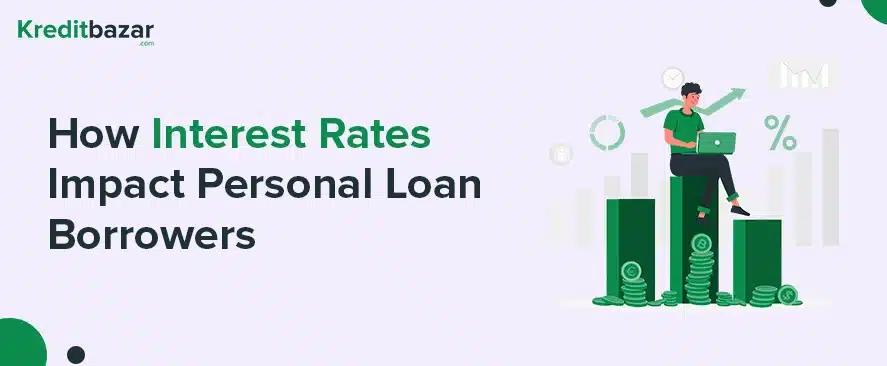![]()
Table of Contents
When taking a personal loan, the interest rate has a direct influence on your monthly payments, total repayment cost, and even your credit score. At Kreditbazaar, we aim to help borrowers understand the importance of selecting the right interest rate for their financial well-being. Whether you’re borrowing from a bank or an NBFC, understanding how interest rates affect your Equated Monthly Installments (EMIs), total interest outlay, and credit profile is essential for effective financial planning.
Impact on EMI Payments
The EMI for a personal loan is determined by the loan amount, interest rate, and repayment tenure. Interest rates play a significant role in shaping the affordability of your monthly payments. Higher interest rates translate to higher EMIs, which can strain your monthly budget.
How High Interest Rates Affect Monthly EMI Amounts
- High Interest Rates: If the interest rate on your loan is high, your EMI will increase proportionally. This is because the cost of borrowing becomes more expensive, and a larger portion of your EMI goes towards paying interest rather than the principal loan amount.
- Lower Interest Rates: Conversely, a lower interest rate reduces your EMI, making the loan more affordable. More of your monthly payment will go towards repaying the principal, which helps you clear the loan faster and reduces the total interest paid over time.
People Also Read: How to Get the Best Interest Rate on Personal Loans
Example of How a Small Change in Interest Rates ImpactsTotal Repayment
Let’s take an example of a personal loan of ₹5 lakh for a tenure of 5 years.
- At 12% interest: Your EMI would be approximately ₹11,122 per month. Over the 5 years, you would pay around ₹1,67,320 in total interest.
- At 14% interest: The EMI would rise to ₹11,634 per month. Over the same period, the total interest would increase to ₹1,98,040.
A small change of just 2% in the interest rate results in an additional ₹30,720 in interest payments over the loan tenure. This example highlights the importance of securing the lowest possible interest rate, as even slight differences can significantly impact your total repayment.
Total Interest Payable Over Loan Tenure
Understanding the total interest payable over the tenure of your personal loan is essential for budgeting and financial planning. Interest rates directly affect how much you end up paying in addition to the principal loan amount.
Importance of Understanding Total Interest Outlay
The total interest outlay refers to the total amount you pay in interest over the entire loan period. The higher the interest rate, the larger this figure will be, increasing the overall cost of the loan. Even though lower EMIs spread the payment burden over time, choosing a higher interest rate or longer tenure can significantly increase the total cost of the loan.
Example of How Interest Rates Affect the Overall Loan Cost
Consider the same loan example of ₹5 lakh over 5 years:
- At 10% interest: The total interest paid would be approximately ₹1,37,320.
- At 16% interest: The total interest would increase to around ₹2,24,060.
As this example demonstrates, choosing a higher interest rate results in ₹86,740 more in interest payments over the same loan tenure. By focusing on minimising the interest rate, you can reduce the overall loan cost and ensure that more of your monthly payments go toward the principal rather than interest.
People Also Read: Personal loan rate of interest SBI
Impact on Credit Score
Your ability to consistently pay your EMIs directly impacts your credit score. Maintaining a healthy credit score is vital for accessing favourable loan terms in the future, including lower interest rates.
How Consistently Paying EMIs Can Improve Your Credit Score
Consistently paying your EMIs on time reflects positively on your credit report. Every timely payment is recorded and reported to credit bureaus like CIBIL. Over time, this improves your credit score, which can result in:
- Better Loan Terms: A higher credit score increases your chances of securing future loans at lower interest rates and more favourable terms.
- Enhanced Creditworthiness: Lenders are more likely to trust borrowers who demonstrate a history of responsible financial behaviour.
To maximise the benefits, it’s essential to ensure that you set up reminders or automatic payments for your EMIs, preventing any missed or delayed payments.
The Risk of Defaulting on Personal Loans with High Interest Rates
Borrowers who take loans with high interest rates might struggle with large EMIs, increasing the risk of default. If you fail to make timely payments, several negative consequences can occur:
- Credit Score Damage: Missed or delayed payments are reported to credit bureaus, which can significantly lower your credit score. A poor credit score can make it difficult to obtain future loans or lead to higher interest rates.
- Penalty Fees: Lenders often impose penalty interest or late fees for missed payments, further increasing your financial burden.
- Legal Action: In extreme cases of prolonged default, lenders can take legal action or initiate loan recovery proceedings, which can further harm your financial standing.
Taking out a personal loan at a manageable interest rate and ensuring timely payments is crucial to maintaining a good credit score and financial health.
People Also Read: Prepayment and Foreclosure Charges in Personal Loan
Conclusion
Interest rates have a profound impact on personal loan borrowers. From determining your monthly EMIs to affecting the total interest paid over the loan tenure, understanding the implications of interest rates is critical for effective financial planning. Additionally, making regular EMI payments can improve your credit score, while defaulting on high-interest loans can have long-term negative consequences. At Kreditbazaar, we help borrowers secure personal loans with competitive interest rates, ensuring that they can comfortably manage their EMIs and maintain a healthy credit profile.
Frequently Asked Questions about Interest Rates Impact Personal Loan Borrowers
Q1. How do interest rates affect personal loans?
Ans1. Interest rates directly impact the EMIs and total repayment amounts on personal loans. A higher interest rate increases your monthly payments and the total cost of the loan, while a lower interest rate reduces these expenses, making the loan more affordable over time.
Q2. How does the interest rate affect the borrower?
Ans2. For borrowers, interest rates determine how much they will pay back over the loan term. Higher interest rates lead to increased monthly payments and overall loan costs, while lower rates make loans more affordable, allowing borrowers to save money on interest.
Q3. Do personal loans go up with interest rates?
Ans3. Yes, if you have a floating interest rate personal loan, your EMIs can increase when market interest rates rise. Fixed-rate personal loans, however, remain unaffected by changes in interest rates.
Q4. How do interest rates affect personal finance?
Ans4. Higher interest rates can strain personal finances by increasing the cost of borrowing, leading to higher EMIs on loans. Conversely, lower interest rates reduce borrowing costs, leaving more room in your budget for savings and other expenses.
Q5. What is a good interest rate for a personal loan?
Ans5. A good interest rate for a personal loan in India typically ranges from 10% to 12%. Rates below 10% are considered excellent and can significantly reduce your loan’s overall cost.
Q6. Is it possible to reduce the personal loan interest rate?
Ans6. Yes, you can reduce your personal loan interest rate by improving your credit score, opting for a shorter tenure, or refinancing the loan with a lower interest rate. You can also negotiate with your lender for a better rate.
Q7. Is a 5.6% interest rate good?
Ans7. Yes, a 5.6% interest rate is considered extremely low for a personal loan. Typically, personal loan rates in India start from 10%, so securing a 5.6% rate would be highly favourable.
Q8. Who benefits from high interest rates?
Ans8. Lenders and financial institutions benefit from high interest rates as they earn more from the interest payments. Borrowers, however, may find loans more expensive, making it less attractive to take on new debt.
Q9. What happens to loans when interest rates fall?
Ans9. When interest rates fall, borrowers with floating-rate loans benefit from lower EMIs and reduced total interest payments. Fixed-rate loan holders, however, do not see a change unless they refinance the loan at a lower rate.
Q10. What rate is too high for a personal loan?
Ans10. In India, an interest rate above 18% is generally considered too high for a personal loan. Borrowers should aim for rates between 10% and 12%, depending on their credit score and lender’s offers.
Q11. What are the risks of personal loans?
Ans11. The risks of personal loans include high interest rates, penalties for late payments, and the potential to damage your credit score if you default. Additionally, personal loans are unsecured, making them more expensive than secured loans.
Q12. Which bank is best for taking a personal loan?
Ans12. The best bank for a personal loan depends on your financial profile. Through platforms like Kreditbazaar, you can compare offers from multiple banks and NBFCs to find the best rates and terms for your personal loan.
Q13. How does interest rate affect loan amount?
Ans13. A higher interest rate increases the total repayment amount over the loan tenure, making your loan more expensive. Conversely, a lower interest rate decreases the overall cost of the loan, saving you money.
Q14. Is the interest rate fixed for a personal loan?
Ans14. Personal loans can have either fixed or floating interest rates. Fixed-rate loans offer consistent EMIs throughout the loan tenure while floating rates can fluctuate based on market conditions.
Q15. Why is my interest rate so high on my personal loan?
Ans15. High interest rates on personal loans may result from a low credit score, high-risk profile, or extended loan tenure. Lenders may also charge higher rates for unsecured loans or loans with longer repayment periods.
Q16. Is 7% high for a personal loan?
Ans16. No, a 7% interest rate is considered very low for a personal loan, as rates typically start around 10% in India. Securing a rate this low would be beneficial for the borrower.
Q17. Is 12% high for a personal loan?
Ans17. A 12% interest rate for a personal loan is average in India. It’s not the lowest, but it’s competitive for borrowers with a decent credit score. Those with better credit may qualify for rates below 10%.
Q18. How to get the lowest interest rate on a personal loan?
Ans18. To get the lowest personal loan interest rate, improve your CIBIL score, opt for a shorter loan tenure, and compare multiple offers from lenders. Kreditbazaar helps borrowers find competitive rates from top banks and NBFCs.
Q19. Can I negotiate my personal loan interest rate?
Ans19. Yes, you can negotiate your personal loan interest rate with the lender, especially if you have a strong credit history or a good relationship with the bank. Lenders may offer lower rates to retain good customers.
Q20. Can I ask my bank for a lower interest rate?
Ans20. Yes, you can ask your bank for a lower interest rate on your personal loan, particularly if market rates have dropped, or your credit profile has improved since you took out the loan.
Q21. How to avoid interest on a personal loan?
Ans21. It is impossible to completely avoid interest on a personal loan, but you can minimize it by choosing a shorter tenure, paying extra EMIs, or prepaying the loan early to reduce the interest burden.
Q22. Do borrowers benefit from high interest rates?
Ans22. No, borrowers do not benefit from high interest rates. Higher rates increase the cost of borrowing, leading to higher EMIs and total repayment. Borrowers benefit from lower interest rates, which reduce their financial burden.
Q23. What are the negative effects of high interest rates?
Ans23. High interest rates increase monthly EMIs and the total cost of the loan, making borrowing expensive. They can also discourage borrowing, reduce consumer spending, and lead to a higher risk of loan defaults.
Q24. Does the interest rate affect loans?
Ans24. Yes, interest rates directly affect loans by determining the EMI amount and total cost. A higher rate increases your repayment amount, while a lower rate makes the loan more affordable.
Q25. Are personal loans affected by interest rates?
Ans25. Yes, personal loans are affected by interest rates, especially those with floating rates. As market interest rates fluctuate, so do the EMIs and total repayment costs for floating-rate loans.
Q26. Who sets personal loan rates?
Ans26. Personal loan interest rates are set by individual banks and NBFCs based on the borrower’s credit score, income, loan amount, and tenure. The rates also reflect the lender’s cost of funds and risk assessment.
Q27. What happens to my loan when interest rates rise?
Ans27. If you have a floating-rate loan, your EMI payments will increase when interest rates rise, making your loan more expensive. Fixed-rate loans remain unaffected by interest rate changes.
Q28. Which bank is best for a personal loan?
Ans28. The best bank for a personal loan depends on your credit score and financial needs. Kreditbazaar helps you compare offers from multiple lenders to find the most favourable interest rates and terms for personal loans.
Q29. How can I lower my personal loan rate?
Ans29. You can lower your personal loan rate by improving your CIBIL score, opting for a shorter tenure, and negotiating with the lender. Consider refinancing if market rates drop, which can reduce your interest rate.
Q30. Is 10% a good interest rate for a personal loan?
Ans30. Yes, a 10% interest rate is considered good for a personal loan in India. If you have a strong credit score, you may qualify for such rates or even lower, depending on the lender.





